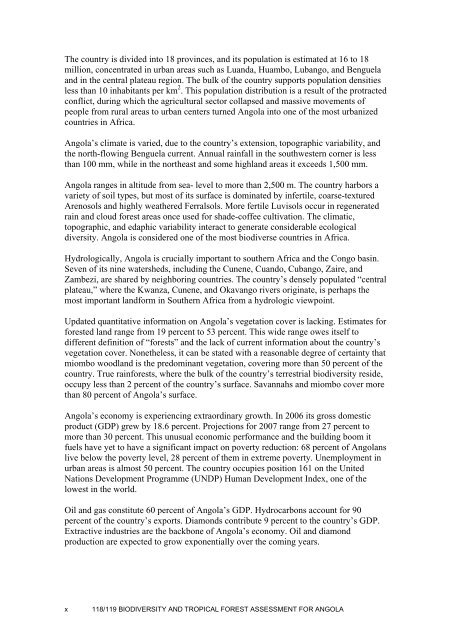118/119 Biodiversity and Tropical Forest Assessment for Angola
118/119 Biodiversity and Tropical Forest Assessment for Angola
118/119 Biodiversity and Tropical Forest Assessment for Angola
- No tags were found...
Create successful ePaper yourself
Turn your PDF publications into a flip-book with our unique Google optimized e-Paper software.
The country is divided into 18 provinces, <strong>and</strong> its population is estimated at 16 to 18million, concentrated in urban areas such as Lu<strong>and</strong>a, Huambo, Lubango, <strong>and</strong> Benguela<strong>and</strong> in the central plateau region. The bulk of the country supports population densitiesless than 10 inhabitants per km 2 . This population distribution is a result of the protractedconflict, during which the agricultural sector collapsed <strong>and</strong> massive movements ofpeople from rural areas to urban centers turned <strong>Angola</strong> into one of the most urbanizedcountries in Africa.<strong>Angola</strong>’s climate is varied, due to the country’s extension, topographic variability, <strong>and</strong>the north-flowing Benguela current. Annual rainfall in the southwestern corner is lessthan 100 mm, while in the northeast <strong>and</strong> some highl<strong>and</strong> areas it exceeds 1,500 mm.<strong>Angola</strong> ranges in altitude from sea- level to more than 2,500 m. The country harbors avariety of soil types, but most of its surface is dominated by infertile, coarse-texturedArenosols <strong>and</strong> highly weathered Ferralsols. More fertile Luvisols occur in regeneratedrain <strong>and</strong> cloud <strong>for</strong>est areas once used <strong>for</strong> shade-coffee cultivation. The climatic,topographic, <strong>and</strong> edaphic variability interact to generate considerable ecologicaldiversity. <strong>Angola</strong> is considered one of the most biodiverse countries in Africa.Hydrologically, <strong>Angola</strong> is crucially important to southern Africa <strong>and</strong> the Congo basin.Seven of its nine watersheds, including the Cunene, Cu<strong>and</strong>o, Cubango, Zaire, <strong>and</strong>Zambezi, are shared by neighboring countries. The country’s densely populated “centralplateau,” where the Kwanza, Cunene, <strong>and</strong> Okavango rivers originate, is perhaps themost important l<strong>and</strong><strong>for</strong>m in Southern Africa from a hydrologic viewpoint.Updated quantitative in<strong>for</strong>mation on <strong>Angola</strong>’s vegetation cover is lacking. Estimates <strong>for</strong><strong>for</strong>ested l<strong>and</strong> range from 19 percent to 53 percent. This wide range owes itself todifferent definition of “<strong>for</strong>ests” <strong>and</strong> the lack of current in<strong>for</strong>mation about the country’svegetation cover. Nonetheless, it can be stated with a reasonable degree of certainty thatmiombo woodl<strong>and</strong> is the predominant vegetation, covering more than 50 percent of thecountry. True rain<strong>for</strong>ests, where the bulk of the country’s terrestrial biodiversity reside,occupy less than 2 percent of the country’s surface. Savannahs <strong>and</strong> miombo cover morethan 80 percent of <strong>Angola</strong>’s surface.<strong>Angola</strong>’s economy is experiencing extraordinary growth. In 2006 its gross domesticproduct (GDP) grew by 18.6 percent. Projections <strong>for</strong> 2007 range from 27 percent tomore than 30 percent. This unusual economic per<strong>for</strong>mance <strong>and</strong> the building boom itfuels have yet to have a significant impact on poverty reduction: 68 percent of <strong>Angola</strong>nslive below the poverty level, 28 percent of them in extreme poverty. Unemployment inurban areas is almost 50 percent. The country occupies position 161 on the UnitedNations Development Programme (UNDP) Human Development Index, one of thelowest in the world.Oil <strong>and</strong> gas constitute 60 percent of <strong>Angola</strong>’s GDP. Hydrocarbons account <strong>for</strong> 90percent of the country’s exports. Diamonds contribute 9 percent to the country’s GDP.Extractive industries are the backbone of <strong>Angola</strong>’s economy. Oil <strong>and</strong> diamondproduction are expected to grow exponentially over the coming years.x<strong>118</strong>/<strong>119</strong> BIODIVERSITY AND TROPICAL FOREST ASSESSMENT FOR ANGOLA
















